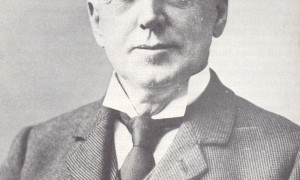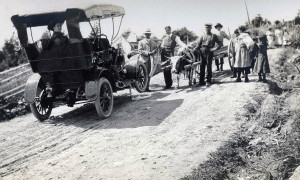Articles
Donald Campbell was the founder of Campbell’s Bay. A pioneer farmer, he received his land grant in 1851. He also ran the local saw mill. The coming of the Pontiac Pacific Junction Railway in 1886 gave a boost to the village, and by the 1920s, Campbell’s Bay had become the county seat.
This cheese factory at Stark’s Corners, just east of Portage-du-Fort, is one of many which sprang up in the 1880s and 1890s as the Pontiac shifted from grain crops to dairy farming. This was probably the largest [cheese factory] in the county.
The steamer lands us at the little village of Portage du Fort, at the foot of the series of rapids down which, from over the falls of the Calumet, the Ottawa thunders. The road, up hill and down gully, which replaces the portage path of ancient days, even now suggests the difficulties which caused this carrying-place to be called “Portage du Fort.”
The original logging camps would start a cut by sending out bush rangers – like Cézar Paul for J. R. Booth on the Coulonge – who would determine the cut. Many former loggers give vivid accounts of their experiences in the bush.
Irish Protestants have made their mark in Quebec both in religion and in economic life. The earliest settlers in the Shawville area were Irish Protestants from County Tipperary who came to Quebec after the Napoleonic Wars. Many Protestants wanted to leave their homeland and find another life away from the constant religious conflict.
The Canadian fur trade was not only one of the first businesses built on this country’s natural resources, but one that involved both European “discoverers” and Indigenous peoples. Sixteenth-century fishermen off Newfoundland’s Grand Banks and in the Gulf of St.
Ezra Butler Eddy, a name long synonymous with the City of Hull, was one of that city’s most successful and influential industrialists. A native of Vermont, E. B. Eddy moved to Hull when he was only twenty-four, bringing with him his modest wooden match manufacturing business. With the help of his wife, Zaida, E.
Told by Harry Richardson:“After the logs were cut, I would work on the river drives. I’d be down home perhaps a month from the time the logs were out before the rivers opened up. When the ice went off, we got the word to go, because you had to drive the logs when the water was high and the water ran off quick up there.
This article was first presented as a conference paper in 1981.It was published in l’Outaouais:the Proceedings of the Forum on the Regional Identity of Western Quebec by the Institut d’histoire et de recherche sur l’Outaouais (Hull, 1982). The Société d’histoire de l’Outaouais has generously allowed the Historical Society of the Gatineau to print this version of it.
The Equity, Pontiac’s only bilingual weekly, has been “the voice of the Pontiac” since 1883. Smith and Cowan started the paper in Bryson. After a number of moves, its present location is the 1850s Shawville Academy building. Its mandate is to report regional news for the people of Pontiac County.
Thanksgiving Day, October 18, 1900, was a beautiful autumn day in the Ottawa area. The weather was sunny but cool, with a temperature about 60 degrees Fahrenheit. The trees in the Gatineau Hills were ablaze in their autumn colours.
The word “bootlegging” apparently came into general use in the American Midwest in the 1880s. It denoted the practice of concealing flasks of illicit liquor in boot tops when going to trade with Indians.
THE GATINEAU
Toponymy is the study of place names. Herewith is a short list of Gatineau places and how they received their names…
Gatineau
The Gatineau River and the City of Gatineau were named after Nicholas Gatineau dit Duplessis, notary of Trois Rivières, Quebec. In about 1650, Gatineau tired of the hum-drum life and, wishing to return to his beloved France, turned to hunting and trapping on the Gatineau River to gather the needed cash for his voyage home. Gatineau did not realize his dream; legend tells us that he drowned in the river that now bears his name.
For over 150 years, a general store was operated by the Thomson family at the corner of Victoria and Galipeau Streets, the main east-west and north-south crossroads in the very centre of the village of Thurso. History passed by its doorstep and the news of its inhabitants could be heard within its doors.
Judge Thompson House is a superb survivor from the first half of the nineteenth century. Overlooking Gerard D. Levesque Boulevard in New Carlisle, the house dates back to c.1838 and is one of the oldest buildings on this part of the Gaspé Coast.
Building the First Metis Beach Lighthouse
In 1873, R. Cameronof Lancaster,Ontario, was given the contract to build a lighthouse at Metis. Cameronhad already built several lighthouses along the St. Lawrence near the Thousand Islands. The construction cost $3518 of which the lighting and accessories accounted for $1425. The lighthouse was built of wood and was 40 feet high. The Light tower was made of iron and 7 1/2 feet in diameter.
One of the finest examples of mid-nineteenth century architecture on the Gaspé Coast is the mansion known as Hamilton Manor.
Gaspé, the scene of many historic events across the years, witnessed dramatic events in September 1758.
The great French fortress of Louisbourg had surrendered to the British forces in August. An expedition was then organized and dispatched to Gaspé to destroy French settlements and shipping in the Gulf of St. Lawrence. Sir Charles Hardy and Brigadier-General James Wolfe were in command of the naval and military forces respectively.
In the summer of 1909, a remarkable automobile journey was made from New Carlisle to Roche Percé. It would be considered ordinary today, hardly noteworthy even if travelling in an antique car. At the time, however, it was a different matter.

